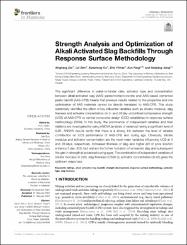| dc.contributor.author | Dai, Xinghang | |
| dc.contributor.author | Ren, Lei | |
| dc.contributor.author | Gu, Xiaozhong | |
| dc.contributor.author | Yılmaz, Erol | |
| dc.contributor.author | Fang, Kun | |
| dc.contributor.author | Jiang, Haiqiang | |
| dc.date.accessioned | 2022-11-14T10:31:28Z | |
| dc.date.available | 2022-11-14T10:31:28Z | |
| dc.date.issued | 2022 | en_US |
| dc.identifier.citation | Dai X, Ren L, Gu X, Yilmaz E, Fang K and Jiang H (2022) Strength Analysis and Optimization of Alkali Activated Slag Backfills Through Response Surface Methodology. Frontiers in Materials, 9, 844608. https://doi.org/10.3389/fmats.2022.844608 | en_US |
| dc.identifier.issn | 2296-8016 | |
| dc.identifier.uri | https://doi.org/10.3389/fmats.2022.844608 | |
| dc.identifier.uri | https://hdl.handle.net/11436/7019 | |
| dc.description.abstract | The significant difference in water-to-binder ratio, activator type and concentration between alkali-activated slag (AAS) paste/mortar/concrete and AAS-based cemented paste backfill (AAS-CPB) means that previous results related to the properties and mix optimization of AAS materials cannot be directly translated to AAS-CPB. This study statistically identifies the effect of key influential variables such as silicate modulus, slag fineness and activator concentration on 3- and 28 day unconfined compressive strength (UCS) of AAS-CPB by central composite design (CCD) established in response surface methodology (RSM). In this study, the prominence of independent variables and their relations are investigated by using ANOVA (analysis of variance) having a significant level of 0.05. ANOVA results certify that there is a strong link between the level of variable contribution on UCS performance of AAS-CPB and curing age. Obviously, silicate modulus and activator concentration are the most major variables influencing UCS at 3 and 28 days, respectively. Increased fineness of slag and higher pH of pore solution enhance 3 day UCS, but restrain the further hydration of unreacted slag and subsequent the gain in strength at advanced curing ages. The combination of independent variables of silicate modulus (0.295), slag fineness (12630.2), activator concentration (0.45) gives the optimum responses. | en_US |
| dc.description.sponsorship | National Natural Science Foundation of China (NSFC) 51804063
Fundamental Research Funds for the Central Universities N2101043 | en_US |
| dc.language.iso | eng | en_US |
| dc.publisher | Frontiers Media | en_US |
| dc.rights | info:eu-repo/semantics/openAccess | en_US |
| dc.subject | Tailings | en_US |
| dc.subject | Alkali activated slag backfill | en_US |
| dc.subject | Strength development | en_US |
| dc.subject | Response surface methodology | en_US |
| dc.subject | Activator type | en_US |
| dc.subject | Slag fineness | en_US |
| dc.title | Strength analysis and optimization of alkali activated slag backfills through response surface methodology | en_US |
| dc.type | article | en_US |
| dc.contributor.department | RTEÜ, Mühendislik ve Mimarlık Fakültesi, İnşaat Mühendisliği Bölümü | en_US |
| dc.contributor.institutionauthor | Yılmaz, Erol | |
| dc.identifier.doi | 10.3389/fmats.2022.844608 | en_US |
| dc.identifier.volume | 9 | en_US |
| dc.identifier.startpage | 844608 | en_US |
| dc.relation.journal | Frontiers in Materials | en_US |
| dc.relation.publicationcategory | Makale - Uluslararası Hakemli Dergi - Kurum Öğretim Elemanı | en_US |


















